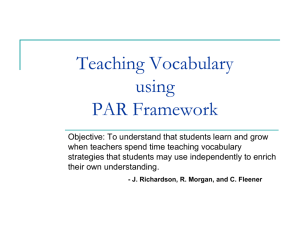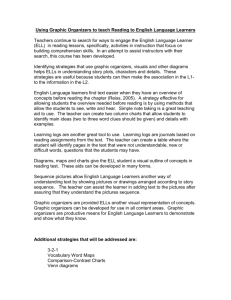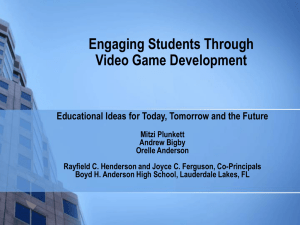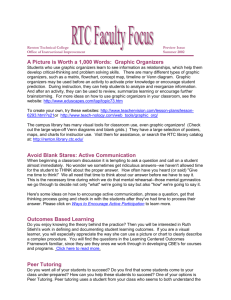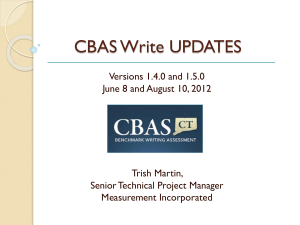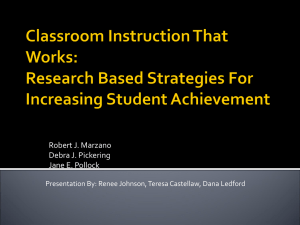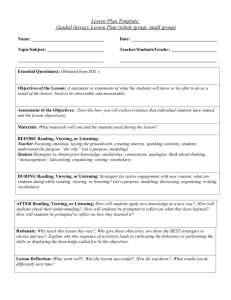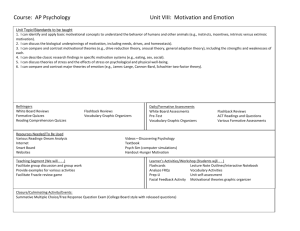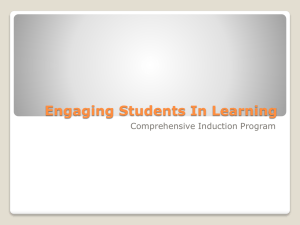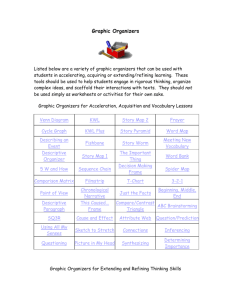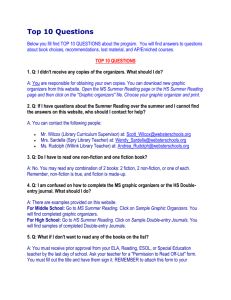Wendy Klassen Grad TAs presentation Oct 2013
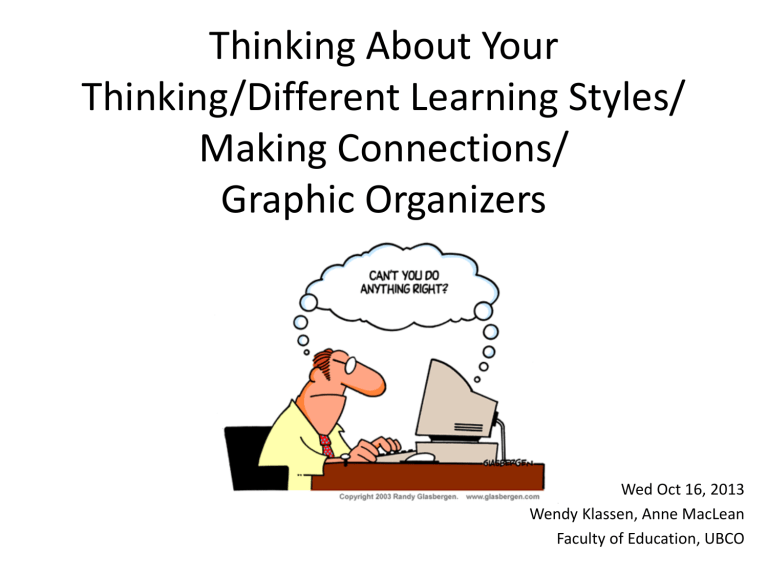
Thinking About Your
Thinking/Different Learning Styles/
Making Connections/
Graphic Organizers
Wed Oct 16, 2013
Wendy Klassen, Anne MacLean
Faculty of Education, UBCO
GOALS
• Make your students’ thinking visible: primarily for themselves, but also for you
• Encourage students to think more deeply
– Past the superficial, passive, filling a vessel notion
– Enrich students’ conceptual understanding
– Personalize the learning
– Make connections
– Think critically
Inclusive Practice for a Wide
Range of Student Needs
…Why?
Colleen Lindsay
School Psychologist
Student Support Services
SD 22 Vernon, BC
Why? This Task May Illustrate
This Question
• Take out a blank piece of paper.
• Draw a picture of a pig.
• You will be presented with the completely nonscientific analysis of your drawing.
Interpretation
• If the pig is drawn:
– Toward the top of the paper, you are positive and optimistic.
– Toward the middle of the paper, you are a realist.
– Toward the bottom of the paper, you are negative and pessimistic.
• If the pig:
– Faces left, you believe in tradition.
– Faces right, you are innovative and active.
– Faces forward (looking at you), you are direct and forthright.
– Faces the rear, seek counseling immediately. (That’s a joke.)
• If the pig is drawn with:
– Many details, you are analytical.
– Few details, you are a risk taker and sometimes commit before analyzing an entire situation.
– Fewer than four legs showing, you are living in a time of major personal change.
– Four legs showing, you are secure and sometimes stubborn.
– More than four legs showing, seek professional help. (Another joke.)
• The size of the ears indicates how good a listener you are – the bigger the better.
• The length of the tail indicates the quality of you love life. The longer the tail, the more fulfilling your love life.
• Did you even draw a tail?
TYPES OF KNOWLEDGE
What our students learn
Type of knowledge
Content knowledge:
‘What to know”facts, vocabulary, concepts etc.
Procedural knowledge:
‘How to’ knowledge- skills, strategies, techniques, procedures etc.
Tacit knowledge:
How our students learn
‘Soft skills’ that help students acquire knowledge: for example, how to...
take notes,
read a textbook,
pace yourself in the allotted time
organize to begin a task
be attentive to details,
ask for help
How Assessed?
Examples
Formative or
Summative
Work samples or portfolios with feedback /response
Rubrics
Quizzes/tests
Free writing
Performance tasks with criteria
Interview or other personal communication
Formative
Observation self-checking strategies
To do lists
Contracts
Templates and graphic organizers
Modelling
Feedback
What motivates our students to learn
Self-knowledge:
For example-
Learning profile: our preferred modes of engagement when learning such as...
Learning style
Multiple Intelligences (MI)
Affect: students’ attributes that directly affect a students’ motivation to learn and predispose them to behave in academically and socially productive (or unproductive) ways such as...
Interests
Attitudes/Anxieties
Aspirations & Efficacy
Formative
Observation
Questionnaires or surveys
(Learning Style, MI,
Interest, Attitude)
Free write: journals, metaphors, poetry
Visual representation: drawing, sculpting, model creation
Metacognition:
- awareness and understanding of one's own thought processes
- active control over the cognitive processes engaged in learning
Assessment AS Learning
Teachers work with their students to bring them into the assessment process so that the students learn to understand
how they are learning as opposed to
what they are learning.
Self-Assessment: An on-going process whereby students reflect on their learning
Association for Achievement and Improving for Learning
Students take responsibility for their learning
Association for Achievement and Improving for Learning
Activities such as planning how to approach a given learning task, monitoring comprehension, and evaluating progress toward the completion of a task are metacognitive in nature.
Metacognitive strategies include mnemonic devices, problem-solving routines, self-monitoring skills, and the use of graphic organizers.
Graphic organizers are designed to assist students in representing patterns, interpreting data, and analyzing information relevant to problem- solving in order to assess their own learning.
CONNECTIONS
What did you have for dinner last Sunday?
Learning is contextual!!
Prior Knowledge Prompt
• Relates new learning to existing knowledge
• Promotes learning by helping students retrieve relevant information and learn with awareness
Mnemonic Devices
• Strategies that students and teachers can create to help student remember content. The verbal information promotes recall of unfamiliar information and content.
• Examples??
Please Excuse My Dear Aunt Sally
BEDMAS
My Very Educated Mother Just
Served Us Nine Pizzas
K
K-W-L or K-W-H-L
W L
K W H L
Before introduction of a topic, students write down and discuss, what they know (K) (or think they know) and what they wonder about or want (W) to learn about the topic. They may also include how (H) they are going to find the information.
Graphic or Visual Organizers http://www.enchantedlearning.com/g raphicorganizers/
Frayer’s Model
Fishbone
PMI – Plus, Minus, Interesting
Venn Diagram
Flowchart
Graphic or Visual Organizers http://www.enchantedlearning.com/g raphicorganizers/
GOALS REVISITED
• Make your students’ thinking visible: primarily for themselves, but also for you
• Encourage students to think more deeply
– Past the superficial, passive, filling a vessel notion
– Enrich students’ conceptual understanding
– Personalize the learning
– Make connections
– Think critically
